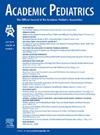有社会风险的青少年和青壮年的社会经济指标和低体重指数结果
IF 2.8
3区 医学
Q1 PEDIATRICS
引用次数: 0
摘要
目的:描述孤立性低身体质量指数(BMI)的青少年和年轻人的临床特征,并确定与此结果相关的生活环境中的社会经济指标。方法:使用我们的电子健康记录,我们进行了一项回顾性病例对照研究,包括135名来自马萨诸塞州资源不足社区的13至21岁的青少年和年轻人,他们被孤立地诊断为发育不良或体重过轻。我们使用疾病控制和预防中心的体重分类将患者分为低BMI和正常BMI两类。我们使用卡方检验和Fisher精确检验来比较BMI结果在临床特征和社区社会经济指标方面的差异,并使用双样本比例检验或逻辑回归来计算效果估计值和95%置信区间。结果:40%的低BMI参与者被诊断为营养不良,需要补充营养。低BMI指数与抑郁、焦虑和未满足的社会健康驱动因素呈正相关,主要是由住房不安全驱动的。讨论:我们的研究结果表明,相当一部分低BMI的aya在其生长发育的关键时期经历了住房不安全感和未满足的社会需求,并遭受营养不良。需要进一步的研究来了解生活环境的作用和低BMI的结果,潜在的机制,以及它对AYA生长和发展的影响。本文章由计算机程序翻译,如有差异,请以英文原文为准。
Socioeconomic Indicators and Low Body Mass Index Outcome Among Adolescents and Young Adults With Social Risks
Objective
To describe clinical characteristics among adolescents and young adults with isolated low body mass index (BMI) and identify socioeconomic indicators in the lived environment associated with this outcome.
Methods
Using our electronic health record, we conducted a retrospective case-control study that included 135 adolescents and young adults ages 13 to 21 from an under-resourced neighborhood of Massachusetts with isolated diagnoses of failure to thrive or underweight status. We used the Centers for Disease Control and Prevention weight classification to allocate patients into low and normal BMI categories. We used chi-square and Fisher exact tests to compare differences in clinical characteristics and neighborhood socioeconomic indicators by BMI outcome and a 2-sample test of proportions or logistic regression to calculate the effect estimate and 95% confidence interval.
Results
Forty percent of the participants with low BMI were diagnosed with malnutrition and required nutritional supplements. Low BMI finding was positively associated with depression, anxiety, and unmet social drivers of health—primarily driven by housing insecurity.
Conclusions
Our findings indicate that a significant proportion of adolescents and young adults with low BMI experience housing insecurity and unmet social needs in their lived environment and suffer from malnutrition at a critical time of their growth and development. Further research is needed to understand the role of the lived environment and outcome of low BMI, the underlying mechanisms at play, and its impact on adolescents' and young adults' growth and development.
求助全文
通过发布文献求助,成功后即可免费获取论文全文。
去求助
来源期刊

Academic Pediatrics
PEDIATRICS-
CiteScore
4.60
自引率
12.90%
发文量
300
审稿时长
60 days
期刊介绍:
Academic Pediatrics, the official journal of the Academic Pediatric Association, is a peer-reviewed publication whose purpose is to strengthen the research and educational base of academic general pediatrics. The journal provides leadership in pediatric education, research, patient care and advocacy. Content areas include pediatric education, emergency medicine, injury, abuse, behavioral pediatrics, holistic medicine, child health services and health policy,and the environment. The journal provides an active forum for the presentation of pediatric educational research in diverse settings, involving medical students, residents, fellows, and practicing professionals. The journal also emphasizes important research relating to the quality of child health care, health care policy, and the organization of child health services. It also includes systematic reviews of primary care interventions and important methodologic papers to aid research in child health and education.
 求助内容:
求助内容: 应助结果提醒方式:
应助结果提醒方式:


